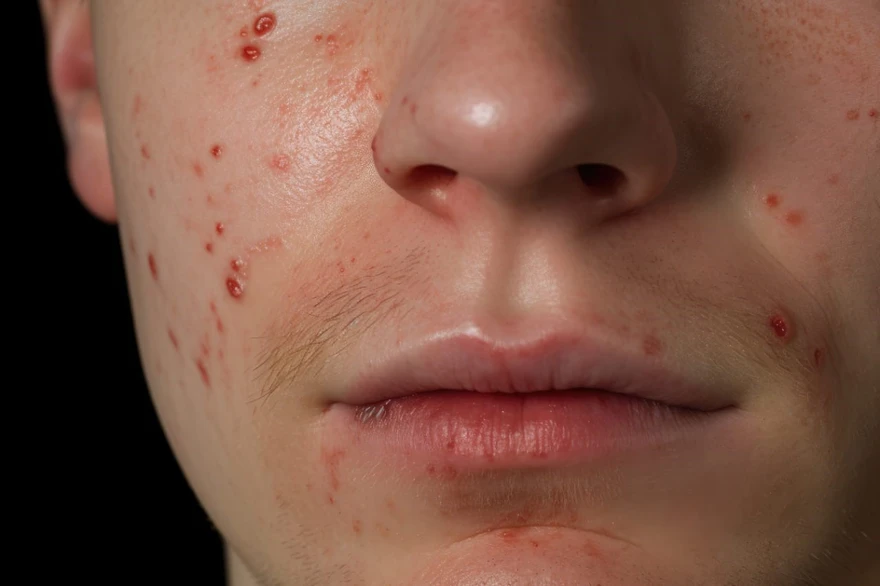Preventive Healthcare
Squamous Cell Carcinoma: Its Symptoms, Causes, Treatment & Types
40 Views
0

Squamous cell carcinoma is a common skin cancer that comes with a variety of symptoms and treatment options. More often people feel anxious upon hearing the term squamous cell carcinoma, but understanding what it includes, how it can present, its causes, and the potential treatments can ease those worries.
This article aims to clarify squamous cell carcinoma and boost your understanding of this health condition, allowing you to feel more informed and at ease. By gaining insight into it, you can significantly lessen any anxiety related to the diagnosis and treatment processes.
What is Squamous Cell Carcinoma?
Squamous cell carcinoma is a common type of skin cancer. It originates in the squamous cells that form the middle and outer layers of your skin. While squamous cell carcinoma generally not a life-threatening, if left untreated, it can grow large or can spread to other areas of the body, causing serious complications.
Early detection is essential because identifying it in its initial stages can help to prevent serious complications. However, if untreated, this type of cancer can result in significant health risks and complicate treatment options for patients in the long run.
What are the Types of Squamous Cell Carcinoma?
Squamous cell carcinoma primarily affects the skin, but it can also develop in other tissues containing squamous cells, such as the lungs, mouth, and tongue.
The most common types include:
- Cutaneous Squamous Cell Carcinoma (cSCC): This type develops on the skin and is frequently linked to prolonged exposure to UV radiation.
- Lung Squamous Cell Carcinoma: This type develops in the lining of the bronchial tubes in the lungs.
- Oral Squamous Cell Carcinoma: This occurs inside the mouth, often appearing as a persistent sore or rough patch.
- Squamous Cell Carcinoma of the Tongue: This subtype specifically manifests on the tongue, often causing concerning symptoms.
Each type of SCC presents unique symptoms and necessitates specific diagnostic methods and treatment plans.
Who does Squamous Cell Carcinoma Affect?
Squamous cell carcinoma can affect anyone, regardless of their age, gender, or ethnicity. However, people with lower levels of melanin in their skin might be at a higher risk of developing this condition. Melanin is what gives the skin its color and helps protect it from harmful ultraviolet (UV) radiation. Due to this, individuals with Black or brown skin, who have more melanin, are usually are less susceptible to this type of cancer compared to those with lighter skin.
Squamous cell carcinoma is commonly found in individuals with light-colored eyes, blond or red hair, and skin that burns easily in the sun. Having a history of sunburns, particularly those that lead to blisters during childhood or adolescence, can significantly raise the risk. Furthermore, individuals with weakened immune systems due to medical conditions like leukemia or , or those undergoing immunosuppressive treatments after organ transplants, also face a higher risk of developing squamous cell carcinoma as time goes on.
How Common is Squamous Cell Carcinoma?
Squamous Cell Carcinoma (SCC) is a common type of cancer in India, occurring as both skin and oral cancer. It represents about 20% of all the skin cancer cases. The chances of developing SCC can vary based on factors like age, gender, and exposure to risks such as UV radiation from the sun and tobacco smoke.
In oral cancer, Squamous Cell Carcinoma (SCC) makes up 90% of cases, with India having over 100,000 new cases each year, the highest in the world. Important risk factors consist of using tobacco, drinking alcohol, diet, HPV infection, genetics, and oral hygiene. Early detection through regular self-examinations is very important for successful treatment.
What are the Symptoms of Squamous Cell Carcinoma?
The squamous cell carcinoma symptoms differ depending on which part of the body it affects.
However, a few common signs include:
- A bump that can vary in size from a pea to a chestnut, often with a rough or scaly surface, resembling a wart.
- A sore that doesn't heal or reappears after healing.
- A flat, reddish, scaly patch larger than 1 inch (2.5 centimeters).
- A new sore or raised area on an old scar, a rough patch on the lip that turns into an open sore, or a sore or rough patch inside the mouth.
It's crucial to consult a healthcare provider if you experience any of these symptoms.
Where on my Body can I get Squamous Cell Carcinoma?
Squamous cell carcinoma can develop anywhere on your body, including areas that that aren't exposed to sunlight. While this cancer most commonly occurs on sun-exposed skin such as the scalp, backs of hands, ears, and lips. But it can also happen inside your mouth, on the soles of your feet, on your genitals, or in other areas of your body.
What Causes Squamous Cell Carcinoma?
The main cause of squamous cell carcinoma is too much exposure to UV radiation, which can come from sunlight or tanning beds. This radiation is found in sunlight and also from artificial sources like tanning beds and lamps.
When UV radiation affects your skin cells, it causes changes in their DNA that can lead to squamous cell carcinoma. Besides UV exposure, other factors like having a weak immune system can also play a role in developing this condition.
Does Squamous Cell Carcinoma Spread?
Yes, if left untreated, squamous cell carcinoma can spread to nearby lymph nodes or other organs. If it infiltrates in deeper tissues or mucous membranes (like lips), the survival rate may reduce because due to the potential complications. The cancer cells can break away and move to other parts of the body, leading to serious problems. However, finding and treating the cancer early greatly lowers the risk of this happening.
How is Squamous Cell Carcinoma Diagnosed?
Doctors typically perform a physical examination, take a biopsy (sample of suspicious skin) for lab testing, and ask for a detailed medical history. A biopsy usually involves removing a small piece of the affected skin and sending it to a laboratory for analysis.
What tests diagnose squamous cell carcinoma?
Diagnosing squamous cell carcinoma involves several important tests that help determine the presence and extent of the cancer.
- Skin exam: The doctor checks for abnormal moles or pigmented areas.
- Biopsy: A tissue sample is taken for lab analysis, with types including shave, punch, incisional, and excisional.
- Blood test: A complete blood count (CBC) is commonly used to assist in diagnosis.
- Imaging tests: CT scans or MRIs assess the size of the carcinoma and check for spread.
- Lymph node biopsy: Nearby lymph nodes are removed to look for cancer signs.
- Nasopharyngolaryngoscopy: A flexible camera examines the throat through the nose.
These diagnostic methods are crucial for identifying squamous cell carcinoma. Quick biopsy results can lead to effective treatment, and complete removal of the tumor may cure the cancer without further intervention.
What are the Stages of Squamous Cell Carcinoma?
Squamous cell carcinoma (SCC) has four stages that indicate how far the cancer has spread in the body:
- Stage 0: The cancer is only in the epidermis, the top layer of skin, also known as carcinoma in situ (CIS).
- Stage 1: The cancer has spread deeper into the skin but has not reached nearby lymph nodes or healthy tissues.
- Stage 2: The cancer has advanced further into the skin and may have affected lower layers or nerves, but it has not spread to lymph nodes or healthy tissues.
- Stage 4: The cancer has spread to at least one distant organ, such as the lungs, liver, brain, or other parts of the skin.
Understanding the stage helps doctors determine the most effective treatment options.
How is Squamous Cell Carcinoma Treated?
The treatment for squamous cell carcinoma varies based on factors such as the cancer's severity and location.
- Mohs Micrographic Surgery: A precise technique that removes cancerous skin layer by layer.
- Excisional Surgery: Involves cutting out the cancer along with some surrounding healthy tissue.
- Electrosurgery: Uses electrical currents to destroy cancer cells.
- Cryosurgery: Freezes the cancer cells to eliminate them.
- Radiation: Targets cancer cells with high-energy rays.
- Photodynamic Therapy: Uses light-sensitive drugs activated by light to kill cancer cells.
- Systemic Drugs: Medications that affect the entire body, used in advanced cases.
Each treatment option comes with potential side effects and risks, so it’s important to discuss these with your healthcare provider. Consult your doctor to determine the best treatment plan for your situation.
What are the Side Effects of Squamous Cell Carcinoma Treatments?
Each of the squamous cell carcinoma treatment has potential side effects, ranging from minor discomfort to more serious issues.
Some common side effects include:
- Pain at the treatment site
- Scarring
- Changes in skin colour
- Fatigue (with radiation therapy)
Discuss these potential side effects with your doctor before starting any treatment plan.
How Can we Prevent Squamous Cell Carcinoma?
Preventing squamous cell carcinoma primarily involves protecting your skin from the UV radiation. As well as avoiding excessive sun exposure, using sunscreen, wearing protective clothing, and not using tanning beds or lamps.
What Can we Expect If we Have Squamous Cell Carcinoma?
With an early detection and suitable treatment, the majority of individuals fully recover from squamous cell carcinoma. The survival rate is significantly high when the cancer is identified early. However, it's crucial to attend all the follow-up appointments with your doctor, as squamous cell carcinoma can recur. If detected early and treated quickly, the outlook for squamous cell carcinoma is usually very positive. Nonetheless, regular check-ups are important to avoid any recurrence or complications.
When to See a Doctor?
If you notice any unusual growths on your skin or experience symptoms of squamous cell carcinoma, get medical advice right away. Early detection is crucial for effective treatment and management.
What is the Difference between Squamous Cell Carcinoma and Basal Cell Carcinoma?
Both basal cell carcinoma and squamous cell carcinoma are types of skin cancer, but they develop in different cells. Basal cell carcinoma begins in the basal cells found in the lower layer of the skin. It is the most common type of skin cancer and is usually less aggressive than squamous cell carcinoma.
In contrast, squamous cell carcinoma begins in the squamous cells of the outer layer of the skin and can spread more readily if not treated promptly.
What is Squamous Cell Carcinoma in Situ?
Squamous cell carcinoma in situ (Bowen's disease), is an early stage of squamous cell carcinoma. In this condition, the cancer cells are still confined to the upper layer of the skin and have not invaded deeper tissues. Although it is not invasive yet, early detection and treatment are crucial to stop it from developing into more serious types of skin cancer.
Conclusion
Understanding and recognising the symptoms of squamous cell carcinoma is crucial for timely diagnosis and treatment. By being informed, you can take charge of your health and act quickly. If you notice any unusual changes in your skin that don’t heal, or rough patches, it’s important to consult a healthcare provider right away. Early intervention can make a big difference in your outcome.
At Metropolis Healthcare, we offer advanced diagnostic services, including blood testing for related markers. Our qualified technicians can conveniently collect samples from your home. Test reports are readily available online, making it easy for you to stay on top of your health and access your medical information conveniently.
With accurate information and reliable healthcare services, prioritising your health becomes easy and achievable. So take that first step towards health awareness today!
 Home Visit
Home Visit Upload
Upload













1701259759.webp)









 WhatsApp
WhatsApp